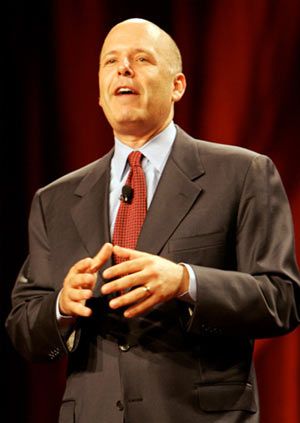US AND UK CUSTOMERS WILL SWITCH MORE THAN $60 BILLION OF BUSINESS IN 2014 IF SERVICE POOR
US AND UK CUSTOMERS WILL SWITCH MORE THAN $60 BILLION OF BUSINESS IN 2014 IF SERVICE POOR
Published by Gbaf News
Posted on March 11, 2014

Published by Gbaf News
Posted on March 11, 2014

Improving customer experience, across multiple service channels, is an increasing concern for Financial Services organizations writes Richard McCann.

Jeff Bezos Amazon
‘There is only one boss’, explained Wal-Mart Founder Sam Walton. ‘The customer. And he can fire everybody in the company from the chairman on down, simply by spending his money somewhere else’.
New York Times bestselling author Shep Hyken[i] warns that if your business fails to give customers a positive experience ‘you risk being one of the companies that collectively has lost $41 billion when customers switched to a competitor’.
Hyken is referring to US losses. The UK adds a further $20 billion[ii] to the total.
No wonder that 91% of financial services businesses say their ‘future growth depends on making customer experience special’ and 81% are ‘planning to invest more in customer management’.

Martin Scovell
I caught up with Martin Scovell, CEO of iBPM software specialist MatsSoft at this week’s New York’s BPM for Financial Services Conference: “From my perspective there’s a hierarchy of needs that is forcing organizations to focus on new channels and improved processes. This starts with addressing the challenge of delivering superior customer experience.”
“To do that they need to offer a good service. They know they need to leverage all the channels available to them. For most businesses digital is the most powerful and potentially the most disruptive channel. To fully exploit the digital channel they need good processes or else service levels will be poor. This puts business process management at the heart of all customer experience initiatives, and if organizations neglect process improvement, investments in automation may prove wasteful and unsuccessful.”
A resounding 94% of all US and UK customers surveyed[iii] would take ‘some action’ the first time service levels failed to meet their expectations. And while the British are sometimes perceived to be tolerant of poor service, however, the same survey indicates 42% would take their business to a competitor ‘immediately’ if they were dissatisfied with service.
North American customers still lead the way though, with 58% of respondents saying that if they experience poor customer service they never use that company again.
And in an era when some people think the youngest are the fastest to voice their dissatisfaction, in fact the 55+ generation was found to be the most impatient of all groups questioned.
Clearly loyalty does not increase with years!

Shep Hyken
“The financial services industry is learning”, says Martin Scovell, “that BPM can represent a move from improvement to innovation.
“The two are often confused but they’re very different”, he explains. “A policy of continuous improvement can give the illusion that a company is innovating, when in truth radical transformation is what’s actually required. Some businesses need a crisis to force them to innovate; but in truth innovation should be continuous rather than episodic and not seen as a last resort. Innovation should be your obsession; part of your company’s DNA.”
Pretty much every bunch of statistics and reports one reads say that customer experience improvement is the top priority for the C-Suite in 2014. Is this reflected in in how organizations are deploying BPM technology?
“Very much so”, says Scovell. “Around 80% of our clients come from the Financial Services sector. More often than not the goal of their BPM initiative is about improving customer service. For example, automated email or text alerts that put customers more in control of their bank accounts; or streamlining the account opening process to accelerate customer on-boarding; or providing call center agents and brokers complete transparency of how mortgage applications are progressing.
“The no-brainer is that if you offer better service you will get more work. It doesn’t matter what industry you’re in, that’s a fact. And if you don’t, your customers will punish you. Pre-digital, an unhappy customer might tell four people. Through social media a single customer may now tell 4,000 people.”
So, given the wide array of technology that’s available to organizations, what suits BPM in particular to the quest of improving customer experience?
“I think what we’re seeing is more and more operational departments need the agility to innovate without the restraints and long lead times typically involved with centralized IT. It’s not about ripping out legacy systems and rebelling against IT. Far from it, integration with legacy systems is essential. Today’s BPM platforms are ideally suited to this paradigm, particularly if like MATS they adopt a Cloud deployment approach, which enables operational teams to get started, without waiting for IT to provision servers and install software. So, it’s about keeping the development business friendly, starting from a process perspective, and leveraging the integration, communication and web-deployment capabilities that modern BPM platforms such as MATS provide”.
More than ever, the customer service channel of choice is digital, with 85% of businesses relying on this as their preferred method of communication.[iv] And as Amazon Founder Jeff Bezos explains: ‘In the old world, you devoted 30% of your time to building a great service and 70% of your time to shouting about it. In the new world, that inverts’.
Richard McCann is a marketing author, journalist and broadcaster.
*Martin Scovell and his MatsSoft team are attending Business Process Excellence for Financial Services, March11-13 at TKP New York Conference Center.
Explore more articles in the Business category











